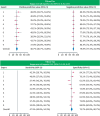Expert assessment of infiltration depth and recommendation of endoscopic resection technique in early Barrett cancer
- PMID: 38873843
- PMCID: PMC11497735
- DOI: 10.1002/ueg2.12604
Expert assessment of infiltration depth and recommendation of endoscopic resection technique in early Barrett cancer
Abstract
Background: Early Barrett cancer can be curatively treated by endoscopic resection. The choice of the resection technique, however-endoscopic mucosal resection (EMR) or submucosal dissection (ESD)-largely depends on the assumed infiltration depth as judged by the endoscopist. However, the accuracy of endoscopic diagnosis of the degree of cancer infiltration is not known.
Methods: Three to four high-quality images (both in overview and close-up) from 202 of early Barrett esophagus cancer cases (82% men, mean age 66.9 years) were selected from our endoscopy database (73.3% stage T1a and 26.7% in stage T1b). Images were shown to 9 Barrett esophagus experts, with patients' clinical data (age, sex, Barrett esophagus length) and biopsy results. The experts were asked to predict infiltration depth (T1b vs. T1a), and to suggest the appropriate endoscopic resection technique (EMR or ESD, or surgery). Interobserver variability (kappa values) was also determined for these parameters.
Results: Overall positive (PPV) and negative predictive values (NPV) to diagnose T1b versus T1a infiltration were 40.7% (95% CI: 36.7, 44.8) and 79.8% (95% CI: 77.5, 81.9), respectively; kappa value was 0.41. Paris classification (kappa 0.51) and suggested treatment also varied between experts. In a post hoc analysis, only the correlation between lesions classified as invisible or flat according to the Paris classification (IIB; 25% of all cases) and the suggested resection technique was better: In this subgroup, EMR was recommended in >80% of cases, with a high complete (basal R0) resection rate (mean of 88.1%).
Conclusions: Precise endoscopic distinction between mucosal and submucosal involvement of Barrett esophagus cancer by experts as a basis for choosing the resection technique has limited predictive values and high interobserver variability. It seems that mainly invisible/flat lesions may result in good resection outcomes when treated by EMR, but this stratification strategy has to be assessed in further studies.
Keywords: Barrett esophagus; early cancer; endoscopic resection; interobserver variability; staging.
© 2024 The Author(s). United European Gastroenterology Journal published by Wiley Periodicals LLC on behalf of United European Gastroenterology.
Conflict of interest statement
None.
Figures




References
-
- Pimentel‐Nunes P, Libânio D, Bastiaansen BAJ, Bhandari P, Bisschops R, Bourke MJ, et al. Endoscopic submucosal dissection for superficial gastrointestinal lesions: European society of gastrointestinal endoscopy (ESGE) guideline—Update 2022. Endoscopy. 2022;54(06):591–622. 10.1055/a-1811-7025 - DOI - PubMed
-
- Fotis D, Doukas M, Wijnhoven BP, Didden P, Biermann K, Bruno MJ, et al. Submucosal invasion and risk of lymph node invasion in early Barrett's cancer: potential impact of different classification systems on patient management. United Eur Gastroenterol J. 2015;3(6):505–513. 10.1177/2050640615581965 - DOI - PMC - PubMed
MeSH terms
LinkOut - more resources
Full Text Sources
Medical
Miscellaneous

